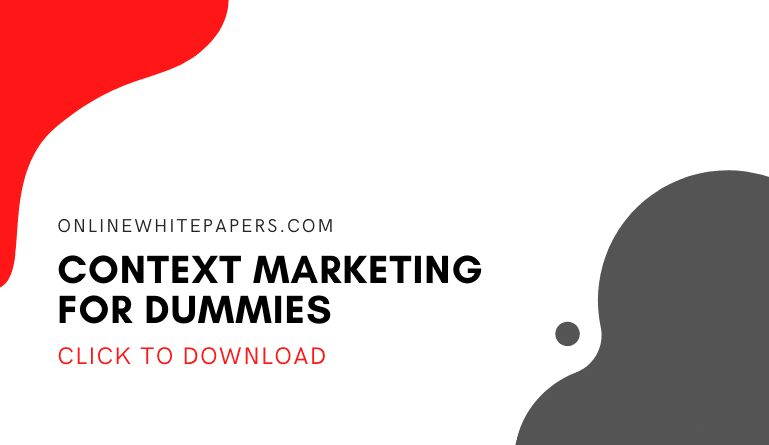At least 42% of B2B marketers claim that their organization’s use of context marketing has been deemed as “very effective”.
What is Context Marketing?
Context marketing, or contextual marketing is all about delivering the right content to the right audience. This ability to market to consumers with the help of user information and recent search history allows marketers to flourish in digital campaigns effectively.
Importance of Context Marketing
It’s a well-known fact that users love to look at content that they love. It’s relevant and caters to what they love most! B2B businesses use context marketing as a tool to enhance all types of digital marketing that needs to be put out. Hence, why digital marketing becomes optimized with the help of context marketing. But, there’s more to a brand winning you over with their products and services.
Who Employs Contextual Marketing?
All different kinds of companies use contextual marketing as a form of advertising. The use of contextual marketing can benefit a business due to its high return-on-investment rates. Businesses employ contextual marketing in order to achieve the opportunity of promoting contextual content to users.
9 Areas to Incorporate Context Marketing
-
Dynamic CTAs
It’s first and foremost that CTA’s should be incorporated in all aspects in marketing. However, when it comes to context marketing, it’s best to make your call-to-actions more dynamic. This will persuade users and encourage them to look into what’s in store with the content you’ve created.
-
Dynamic with Email Content and Workflows
Another area that should have more context marketing is your organizational workflow and email content that gets sent out. The dynamic between your email content and workflow should be well aligned and organized. The best way to organize the flow of email content is through contextual marketing. Your organization can start with email segmentation, which can lead to highly targeted email lists. As for workflows, it’s best that the right content gets assigned, or received by the right person.
-
Smart Forms
The use of Smart Forms is another way that contextual marketing can be incorporated in. A good approach to this is using Smart forms on your landing pages and have visitors or potential leads answer questions as if it were a survey. It’s that easy! Smart Forms will actually increase conversion rates, which is why a majority of companies tend to use Smart Forms for their websites, and other platforms for content.
-
Think Interactions Instead of Campaigns
When establishing a campaign, your company should look at it more as an interaction rather than the campaign itself. Because contextual marketing revolves around making it about the customer, the best way to implement it is through the idea of an “interaction”. When thinking about customer interactions, you think about the possibilities that can come out of successful campaign management.
-
Engage Instead of Targeting
Yes, consumers are considered targets of a brand, product, or organization. However, engaging your customers can increase value to contextual marketing. Your business can benefit from engaging with customers rather than “targeting” them because it makes the entire idea sound more humane, which is what most customers would rather get out of a business aside from good customer service and value.
-
Use Customer Recognition
Having customer loyalty is another strategy to implement contextual marketing into your business. The more customer recognition, the more value in revenue towards your marketing journey. It’s important that marketers use customer recognition as a way to drive more contextual marketing into their business.
-
Seek Customer Moments
On top of customer recognition is seeking moments from customer experience. The main priority with contextual marketing is to really get to know the customer, or the ins and outs of their daily wants and needs. So when implementing context marketing in this area, try to seek out customer expectations, and how can your organization successfully deliver out to those customers.
-
Share Utility
Marketers should consider sharing customer utility. When implementing contextual marketing, organizations should focus on how to drive more engagement by increasing customer interactions. The ripple effect of consumers of spreading the word can truly become effective if organizations use contextual marketing to spread brand awareness.
-
Look for Value Exchange
Finding value exchange in order to implement contextual marketing sounds pretty straightforward. In this case, marketers should take advantage of this by personalizing content for their customers, and creating more exchanges such as VIP treatments, social media shoutouts, coupons, and more exclusive content.
Leveraging the Power of Context Marketing
- Buyer Personas
Buyer personas are a representation of who your target audience is. They aren’t actual customers, but they embody what a typical customer would be like based on basic characteristics of targeted buyers. Using buyer personas to your advantage can help gain insight into the mind of your target audience.
- Buyer Journeys
Aside from buyer personas, buyer journeys are considered essential to the concept of context marketing. Think of a buyer’s journey as a personalized sales process. Digital marketing campaigns can benefit from contextual marketing, especially through buyer’s journeys. This tool can optimize your company’s marketing funnel and innovate the way that you market your products and services digitally.
- Contextual Data
Contextual data can be seen as a “cheat sheet” because it can give you information that you need to know about a person such as your buyers, or a products and services that your company promotes. With contextual data, advertising to your target audience will become easier to understand.
Examples of Contextual Marketing
-
Content Placement
One example that shows contextual marketing at its finest is content placement. Yes, placement does matter, especially when you’re working with contextual marketing. Content can be personalized for visitors on your website depending on what their interests are. Content placement can simply be done in a list-based fashion where you can put URLs that users visit and insert those links into a smart list that will then create content for users.Another strategy would be through event tracking where you can tag your web pages and track them with custom events that can cater to a topic relevant to your company’s purpose.
-
Social Sharing
Social sharing is another example of contextual marketing. This is where you can have the ability to customize social sharing buttons on your website in order to maximize
your reach. This can be done with the installation of said share features, and then running tests to see if the social sharing feature to your site will increase content and social reach.
-
Referral Sources
Referral Sources can be used as a way to welcome new users to your site. This is where contextual marketing can come in handy, especially if you want to use a dynamic CTA, or a banner across your side that greets every visitor that comes onto the site. Remember, simple things do matter online, which is why it’s best to implement contextual marketing at your advantage.
-
Location-Specific or Industry-Specific Case Studies
If you want to build trust with your user, try aligning content that’s relevant to that user’s IP address in order to make content more relatable for the user. This would be an example of a location-specific case study. As for industry-specific case studies, the same process still applies except rather than looking for the exact location, you would align a user’s content based on the industry that they have been associated with.
Final Thoughts
The importance of contextual marketing can be seen worldwide through digital marketing campaigns. Businesses implement contextual marketing to provide excellent customer experience with content that’s data-driven by users. This is one strategy that contextual marketing can win consumers over and create a relationship on a more significant level.
Contextual marketing can also leverage the power of digital marketing with contextual data, buy journeys and personas. A few examples to follow when promoting with contextual marketing would be content placement, referral sources, social sharing, and industry-specific case studies from brands who’ve used contextual marketing. Once your company gets the hang of contextual marketing, you’ll begin to understand what it takes to meet the wants and needs of your target consumers.






